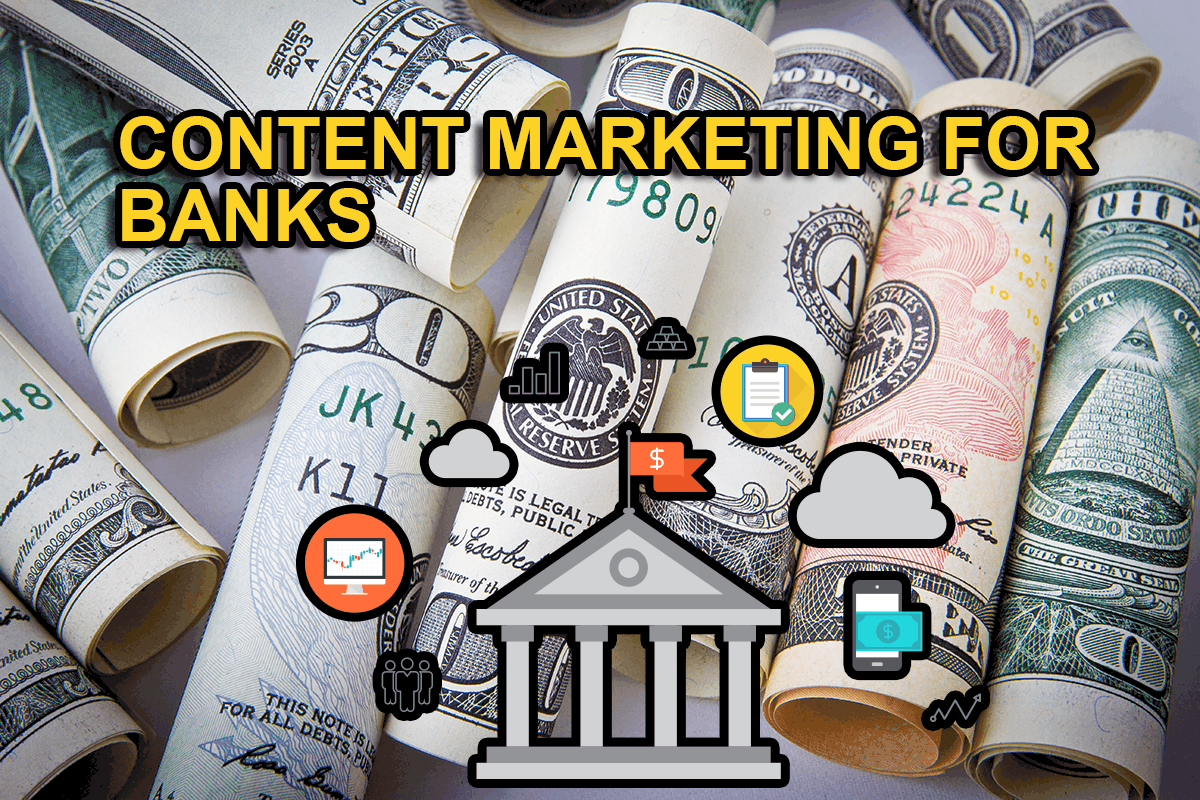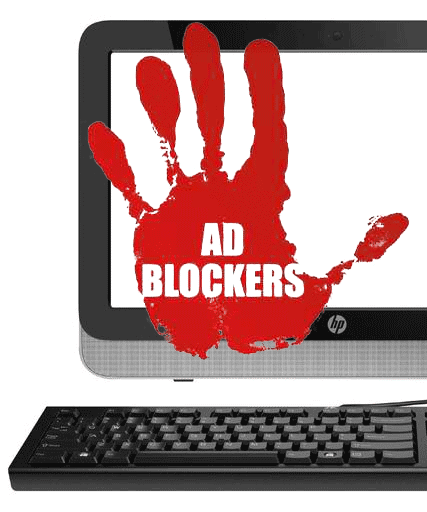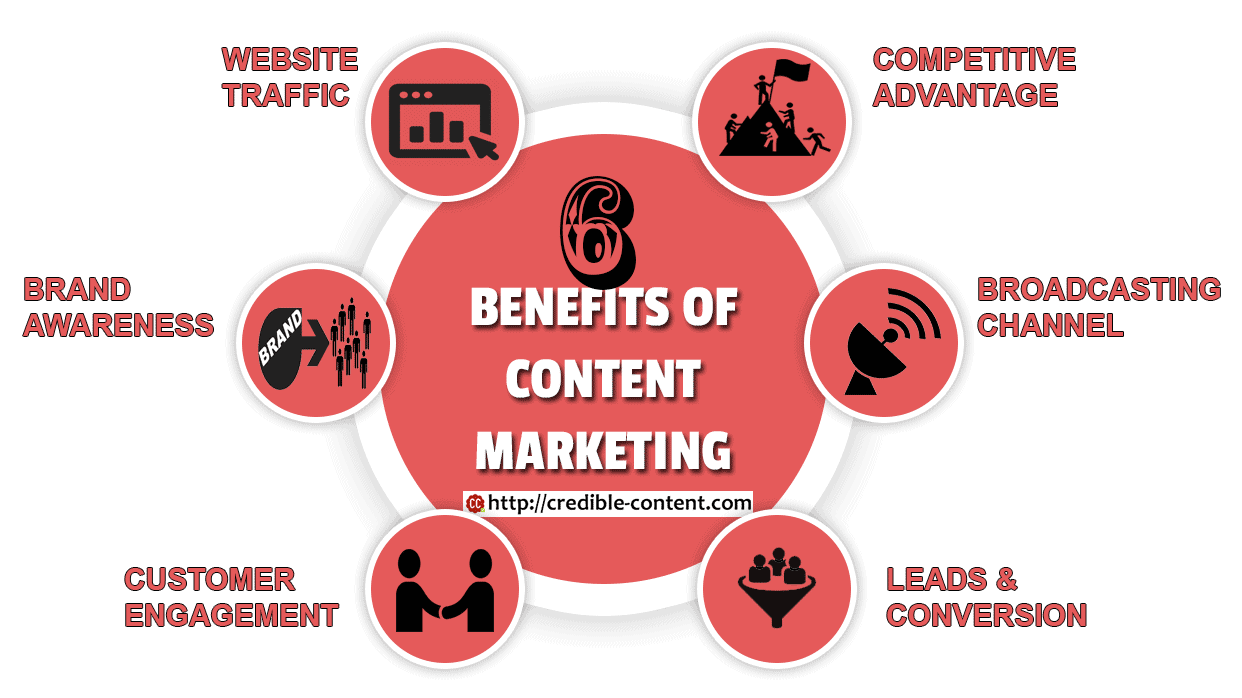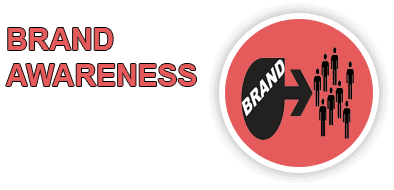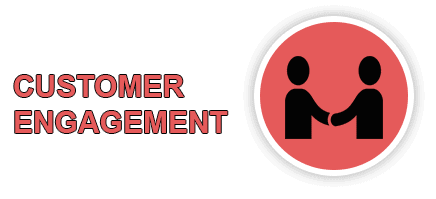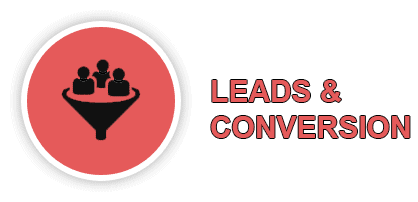
Grow your business with content marketing
How do you plan to promote your small business (I’m assuming you have a website and you need to promote it)?
Google AdWords?
Pay an SEO company to improve your search engine rankings?
Spend hours on social media posting random messages and replying to people?
All these activities are important and I’m not going to discourage you from using a judicious mix of them to promote your small business.
The problem (here we go!) with these activities is that they’re becoming less and less effective.

Conventional advertising has become boring
If you can use AdWords, so can your competitors. If you outbid them, they can outbid you.
And anyway, people on search engines pay less attention to paid links when they’re searching for useful information. The nature of paid links is that people don’t expect these links to contain helpful information.
Even if people do click your paid links, you can easily imagine how much you will end up spending on just a single campaign – businesses run multiple campaigns to cover multiple search terms.
Advertising has been exploited so much that people no longer trust it. In fact, they are constantly looking for ways to skip advertising. Many users have add-ons in their browsers to block advertisements. This is because most of the advertising is always about selling, selling, and selling. People get put off.
Read: Want to know how content marketing is better than advertising?
More than 650 million devices use some form of ad blocking.

Increasing number of people are using ad blockers
The problem with SEO is multi-faceted. Much of SEO these days has to do with good quality content and if you don’t recognize this and want to improve your SEO without investing in high-quality content, you will just spend money and effort without any results. There is no SEO these days without content marketing. You can acknowledge this today, or after a few months, after spending a ton of money and effort.
Moreover, without quality content, SEO is very easy. You can create “optimized” content in great quantity and go on publishing it. Since, low quality content is very cheap, you can use brute force to improve your SEO and sometimes, it actually works (it depends on how much effort your competition is putting).
Read: How content marketing actually improves your SEO
Since it is very easy, and also egotistically gratifying, many people do it. If you can get cheap content, so can your competitors.
Social media is full of noise. Timelines move very fast. There, unless you are paying to highlight your updates, most of your followers are going to miss your messages. You will be constantly catching up.
Since you will be spending most of your effort (and even money) maintaining a presence on social media, you won’t have any intellectual wealth to show for yourself.
Content marketing is the answer.
Here is a nice infographic of how you can use content marketing for making every part of your sales funnel effective.
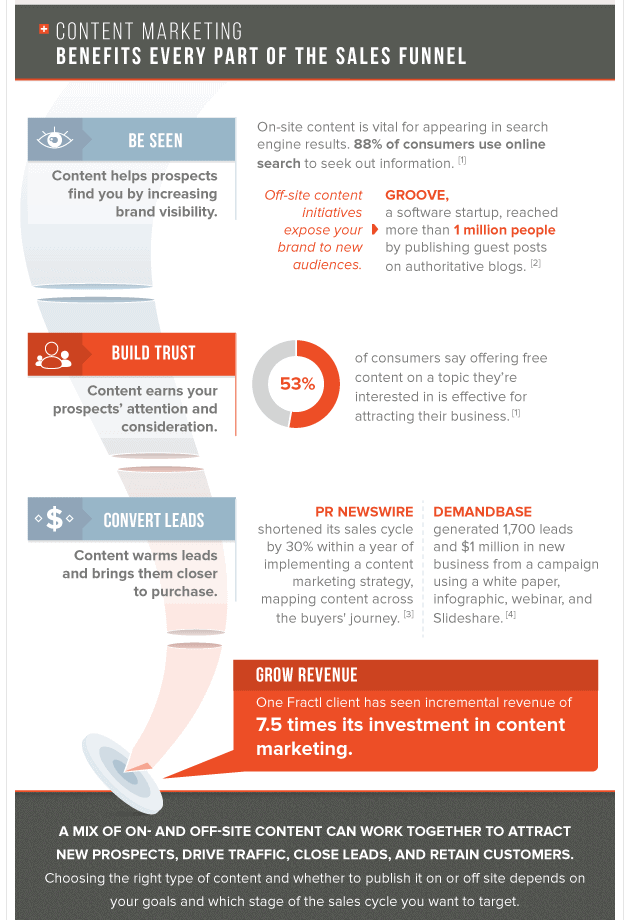
Using content marketing to make every part of your sales funnel effective
Source
Why content marketing is the answer to all your small business growth troubles as far as promotion goes?
First, let us understand what content marketing actually means.
I won’t go into esoteric definitions of content marketing as many blogs have it. I will use very simple language to explain what content marketing to you is, and how you can use content marketing to grow your business.
Isn’t this the ultimate goal, growing your business?
So, what is content marketing? Especially in the context of a small business like yours?
Everything that you publish online is content.
All your web pages on your small business website, are content.
The images accompanying those web pages are content.
The publicly accessible PDFs that you have, are content.
If you are publishing blog posts, they are content.
If you constantly publish FAQs and answers to questions from your customers and clients, they are content.
When you send out an email campaign, that’s content.
When you post updates on Instagram, Facebook, Twitter and LinkedIn, you are publishing content.
So, whatever you publish online for the consumption of people, you are publishing content and in a crude manner, you are also indulging in content marketing. You just don’t know it.
Content marketing means using a strategy to regularly publish content in such a manner that people not only want to get more of your content, they go out of their way to make sure that they don’t miss your content.
Remember that the ultimate aim of content marketing (your content marketing) should be the growth of your small business.
So, when you publish content, when you attract people to your content, they should be your prospective customers and clients, and not all-and-sundry.
If you try to attract all-and-sundry, you will simply waste money and time, which you don’t want.
In the context of your small business, content marketing means publishing useful content using your preferred channel, on an ongoing basis, so that your business name or your brand becomes familiar to people, and since you are publishing useful content, your target audience is not annoyed.
Not being familiar with you is one of the biggest reasons why people on the Internet don’t want to do business with you.
In bulleted form, your small business content marketing would include:
- Publishing high-quality content regularly.
- Providing answers to people’s problems and questions.
- Highlighting the benefits of your product or service from different angles, in different ways.
- Promoting your content using multiple channels like your blog and social media platforms.
- Using analytics to note down what sort of traffic your content is attracting.
- Tweaking and adjusting your new as well as existing content according to the feedback that you got from your analytics tools.
Things you need to know in advance if you want to grow your small business with content marketing
Content marketing is way more effective than the other promotional methods listed and not listed above, but don’t opt for content marketing as a tool for your small business growth thinking that it is cheap.
The key is “content marketing is more effective”.
Sure, you can go for cheap content and then like a hamster you can go on running inside a spinning wheel thinking that you’re doing something very important.
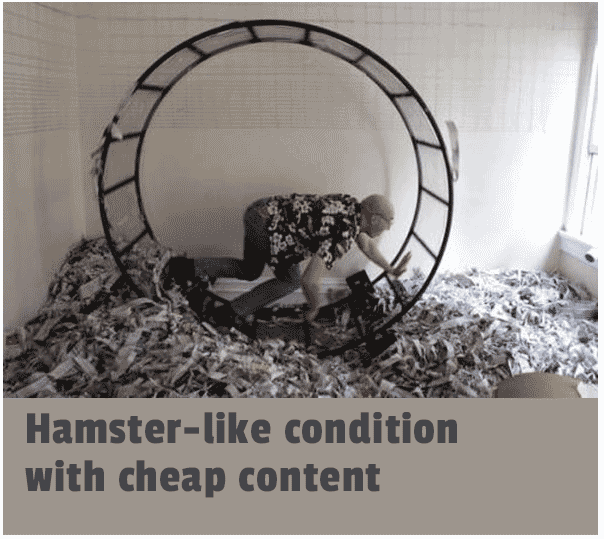
Hamster-like conditions with cheap content
Image credit
Your choice.
I’m not saying that you’re not going to succeed with content marketing unless you go bankrupt. I just mean to say that just like any other advertising and marketing cost, or any other business-related cost, content marketing is going to cost you.
Another thing that you need to keep in mind is that content marketing doesn’t stop at a few blog posts and articles. It is an ongoing process. You can take it as an operational cost.
This is because just like you are using content marketing, so are many more businesses.
You may say that the same thing happens with conventional advertising and SEO, again, I want you to pay attention to “content marketing is more effective”.
Just like SEO, you are constantly going to face competition for your small business in content marketing.
Just like advertising, you may have to spend money getting quality content for your website or blog or social media updates.
Yes, it comes with all the existing attributes like costing money, needing effort, and having to compete with the others.
What makes it different from other forms of marketing is, it is more effective, and if implemented properly, it will certainly help you grow your small business.
So, what makes content marketing so effective for growing your small business?
Don’t roll your eyes, but to benefit from content marketing, you must understand that you are providing something unique.
Unless you yourself recognize the potential of your business – your product or service – how are you going to convince the others? If you are half-hearted about your proposition, so will be the reaction to your proposition.
Once you become a big fan of your business, you have a lot to say.
Compare this with an interesting topic. How easy it is to have a conversation on a topic you find interesting.
Anyway, the biggest benefit of content marketing is that it gives you a unique identity.
A big problem with the Internet is – despite the fact that its potential for your small business is almost infinite – that there is too much noise. The noise doesn’t just come from your competitors. There are millions of distractions on the Internet.
How do you distinguish yourself?
How do people recognize you in the crowd?
Why should they do business with you if scores of other people are prompting them to do business with them?
You give them something to like about you. Something to respect you. Something to hold you in awe.
When they like you, when they respect you, when they hold you in awe, naturally they want to buy from you.
But how do you do that?
One way is to provide them exceptional service once they have bought something from you. But, this can only be done when they have become your customers or clients. What do you do when they haven’t yet become your customer or client?
You can offer them something free.
If it is something digital, although the cost might not be a problem, zillions of digital products on the Internet are free, so, again, people won’t be able to distinguish your small business from others. Heck, even Google provides free Gmail and a stack of other services free of cost. You will be just another service doing the same.
Giving physical products for free will be very expensive. Even giving services for free will be very expensive for a small business.
Providing helpful, good quality content, on the other hand, isn’t very expensive, and people don’t take good quality content for granted because there is so much lousy content available.
What do I mean by good content?
The definition of “goodness” changes from context to context. Some people may find amusing content good – for example creating and distributing funny GIFs. Some people may find fashion tips good. Some people may find recipes good. Some people may find web design and SEO tips good. Some people may find Internet marketing tips good.
Visited boredpanda.com? As the name suggests, it’s a website for people who are bored. So the content over there that unbores them is good content for them.
“Good” here means something that is useful, something that entertains, something that is relevant, and something that is topical, and last but not the least, something that is written well that shows that you respect your readers.
We live in a screwed-up world but fortunately, people still appreciate help, and are grateful for it.
Suppose, you sell scented candles from your website. If you search for the phrase “buy scented candles online” on Google you will see that most of the listings are from famous online retailers. It will be very difficult to get your link featured with these mega-million retail stores. I’m not saying it is impossible, but it is difficult.
What do you do?
You first create a very unique line of scented candles, and then build a community around your business through content marketing.
You have to offer people something that is not available on all these retail shops.
Fine, even if you come up with something very unique, how do you promote your small business with very limited budget?
Through content marketing.
Start posting high-quality pictures of your scented candles on Facebook and Instagram. Invite people to share their experiences of using scented candles from various sources.
Create a video of how you typically create scented candles.
Write blog posts on the process of making scented candles.
Find references of scented candles in classical books and create a blog post on this theme.
Send regular email updates to people on how they can use scented candles for different occasions.
Educate people about the therapeutic benefits of scented candles.
Once you start using content marketing to promote your small business of scented candles, you will keep on coming up with different ideas.
But, no matter how appreciative and grateful we are, we easily forget. We need to be reminded regularly. So, good quality content needs to be published regularly.
For that, create a content publishing and content marketing calendar for your small business.
Remember that there is a reason why it is not called “content publishing” but “content marketing”.
It takes strategy to use content to market your small business.
Once you have released your content into the World Wide Web, you need to make sure that the right people get access to that content. No matter how great your content is, unless your target audience is able to find it, it is not going to achieve the desired results.
Use all the available channels to promote your content. Promote your blog on Facebook, Instagram and Twitter. Build a mailing list and broadcast your links whenever you publish them. Encourage people to subscribe to your mailing list.
Here are some nice statistics published in an infographic on Demand Metric:
- 70% people prefer to learn about a company or a product through articles and blog posts rather than an advertisement.
- 82% customers and clients have a positive outlook about a company after reading content from the company.
- On an average, marketers are spending over 25% of their marketing budget on content marketing.
- 91% B2B marketers use content marketing.
- 86% B2C marketers use content marketing.
- Content marketing costs 62% less than traditional marketing.
- Per dollar spent, content marketing generates approximately three times as many leads as traditional marketing.
- 86% people skip TV advertisements when given the means.
- 90% consumers find custom and informative content useful.
What makes content marketing cheaper and more effective compared to traditional marketing, especially for small business?
Social sharing. Search engine traffic. Direct referrals.
For every non-content marketing promotion, you pay for every benefit that you derive.
When you advertise on Google AdWords, you pay for every click. If you’re paying one dollar per click and if you get 200 clicks in a day, you are spending $ 200 per day for those 200 clicks.
But when you publish high-quality content after adopting content marketing, if your content is good and valuable, people promote that content on their own. You don’t have to pay them to promote your content. It is so valuable that people want to share it with their colleagues, friends and relatives.
The quality of your content, coupled with social sharing, improves your search engine rankings. Whether you get 200 clicks from Google or 2 million clicks, you don’t have to pay even a single cent to Google (or any other search engine). After your initial investment in getting high quality content, the cascading effect is totally free.
The benefits of content marketing for your small business
As you do content marketing for your small business, just in a couple of months you will begin to see the following positive changes:
- Improved search engine rankings (of course, better search engine rankings are needed)
- More targeted traffic to your website
- Increased referral traffic to your small business website, because more websites and blogs will be linking to you and more people will be sharing your links on their social media profiles
- People pay more attention to what you have to say
- More leads are generated from your website and other sources
- Your sales increase
Conclusion
Although, as a small business, you may want to try out many marketing methods, content marketing for small business is not only cost-effective but also result-oriented.
With little creativity, you can gain a competitive edge over businesses that are not using content marketing to promote themselves, or who are using content marketing wrongly.
You can place yourself as an expert or an authority figure if intellectual branding matters in your field. When people respect you for your wisdom, it’s easier for them to do business with you because they trust your intelligence.
You also become familiar to people. When you continuously publish content, people become used to your presence, and not in a negative sense. They associate you with high quality content and timely help.
The overall visibility of your small business increases with consistent and strategic content marketing. More people link to your website. More people share your links. Search engines begin to rank you higher.
Clarity of purpose is very important if you want to promote your small business with content marketing. The entire strength of content marketing lies in strategy and execution. You must know what you want to publish, why you want to publish and what should be the end result. Once you have figured that out, there should be nothing holding you back.

